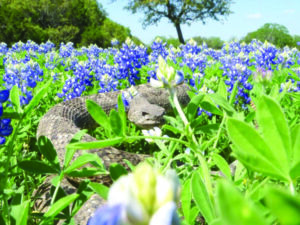By Dr. Beth Leermakers
My dog was bitten by a snake 15 years ago, and I still remember the scary experience vividly. Snowie was digging under the house, clearly in pursuit of a critter. Suddenly he yelped, ran inside, and hid under the bed. His face swelled up within minutes, and Snowie was so uncomfortable he wouldn’t eat a hot dog “pill pocket” (containing medications recommended by our vet). Fortunately, he only needed basic care from our vet, and he recovered quickly.

Photo by Nancy Black
Spring and summer are prime times to see snakes in your yard or on the hiking trails.
There isn’t any common feature shared by all venomous snakes, so you need to be able to recognize the three venomous snake species that live in North Texas.
Copperhead
Copperheads are the most common venomous snakes found in Dallas. This small snake (20-30 inches long) has a light-colored body with chestnut or reddish-brown crossbands. Two subspecies, the Southern copperhead and Broadbanded copperhead, reside in the area. Fortunately, a copperhead’s bite is seldom fatal (to people) because its short fangs (only 1-7 mm long) only contain small amounts of venom.
Rattlesnake
Ten rattlesnake species live in Texas, but the most common and widespread is the Western Diamondback. Western Diamondbacks are pit vipers, meaning they have a heat-sensing pit behind each nostril that can detect differences (even small ones) in temperature.
The snake detects the heat given off by an animal, helping it distinguish between predators and prey. Western Diamondbacks are three to five feet long, with a triangular shaped head, dark diamond-shaped patterns along their back, and black and white bands on the tail, just above the rattles.
Coral Snake
This brightly colored snake is very shy and non-aggressive. However, coral snakes can still cause a serious bite if they’re handled. Coral snakes are about two and a half feet long, with red, yellow and black bands completely encircling their body. A harmless snake, the Scarlet snake, also has red, yellow and black bands. To tell the difference, remember this rhyme: “Red next to black — friend of Jack; red next to yellow will kill a fellow.” Coral snakes have red bands next to yellow ones; Scarlet snakes have red bands next to black (not yellow).

Photo courtesy of Brittany Rescue in Texas
What to Do if You
Spot a Snake
Stop moving and allow the snake to retreat. Snakes don’t prey on people, and they won’t chase you. Instead, they retreat or escape when they can. Venomous snakes are dangerous when they are surprised or cornered. Most bites occur because people take foolish risks with venomous snakes. If you must move when you see a snake, back slowly and carefully away from the reptile.
Do not kill the snake. Snakes serve a valuable function in the environment, eating rats and mice that spread disease and damage property. Snakes also control the tick population by eating the animals that harbor them. Leave snakes, even venomous ones, alone.
Don’t play with (or allow your dog to play with) a dead snake. Dead snakes have been known to bite and inject venom because of muscle contractions.
Contact a humane wildlife control company to remove the live snake, if necessary. AnimalHelpNow is a free app that lists resources for dealing with wildlife, including snakes. Go to the Wildlife Conflict section, which includes two Dallas-area companies:
A Wildlife Pro DFW: 214-606-1987
911 Wildlife: 214-368-5911
What to Do if You’re
Bitten by a Snake
Go immediately to an emergency care facility (emergency room or clinic). If possible, identify the snake so you can tell the doctor, who will provide the right antivenom.
Stay calm and limit physical exertion. Remove all jewelry (bracelets, watches, rings) and restrictive clothing near the bite so these items don’t restrict blood flow if swelling occurs.
Avoid “home remedy” treatments. They are not helpful and may do more harm than good. Forget everything you’ve seen in movies and TV sitcoms.
• Do NOT apply ice to the bite.
• Do NOT make a tourniquet.
• Do NOT make any incision on or near the bite.
What to Do if Your Dog is Bitten by a Snake (Venomous or Not)
The most common signs of a snake bite include swelling, bruising and pain at the site of the bite. If your dog was bitten by a venomous snake, extensive swelling spreads rapidly, and you’ll see bloody discharge at the bite site. The toxin will often lead to shock.
Take your dog to the veterinarian immediately, whether she was bitten by a venomous or non-venomous snake. Depending on the snake/bite, your vet will treat the wound, administer antibiotics and pain medication, give an antivenom (if needed) and treat the side effects (shock and organ compromise).
On the way to the vet, keep the bitten area lower than the heart, if possible. This slows the spread of the toxin. And keep your dog (and yourself) calm.
Avoid first aid remedies before going to the vet. They are not helpful. The best approach is to seek immediate vet attention.
Keep these tips in mind as you enjoy outdoor activities this spring.
